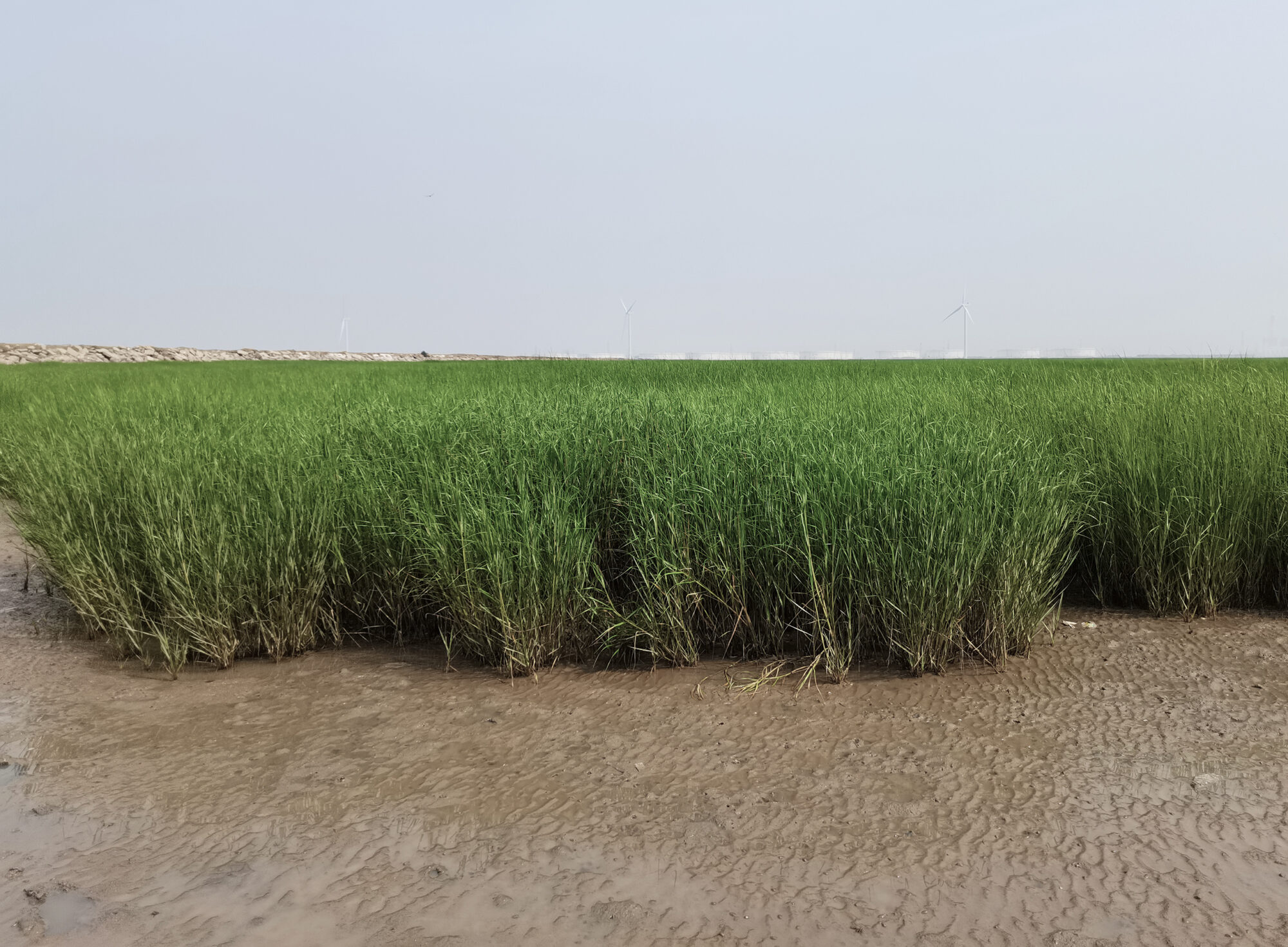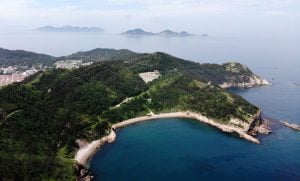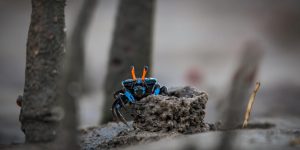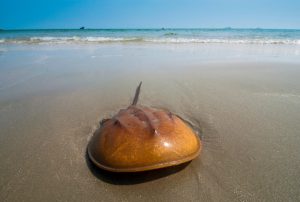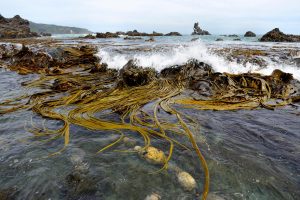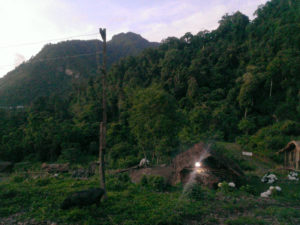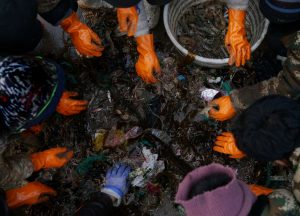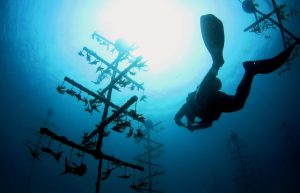Since its introduction four decades ago, salt-water cordgrass (Spartina alterniflora) has been spreading along China’s shores. By this year, researchers studying remote sensing data found it had taken over more than 600km2 – or 48.3% – of the country’s salt marshes.
The grass brings with it a number of problems and removing it is expensive. As an example, 11 years after it was planted on Chongming island in 2001, the Shanghai government was forced to spend over a billion yuan (US$150 million) to remove it.
“Salt-water cordgrass has become one of the biggest threats to China’s coast,” Zhang Zhaohui, a researcher at the Ministry of Natural Resources’ (MNR) First Institute of Oceanology, told China Dialogue. Last year, a 2021–2035 plan for protecting and restoring key ecosystems, published by the National Development and Reform Commission and the MNR, included better prevention and treatment of the damages caused by invasive species such as the cordgrass. Local governments took the hint. Provinces including Shandong and Guangxi have since announced quantitative targets for dealing with the plant.
When first introduced, the salt-water cordgrass was hailed as a “Green Great Wall”. Now it is regarded as the creator of “green deserts”. The tale provides useful warnings about the introduction of non-native species.
From Green Great Wall to green desert maker
In the late 1970s, Chinese scientists travelled to the east coast of the United States and came home bearing salt-water cordgrass. It would, they hoped, help protect China’s shorelines. In 1994, Typhoon Fred struck Wenzhou in Zhejiang province, bringing waves of seven metres and more. While 70% of stone-built dykes were destroyed, 15km survived, thanks to a 200-metre belt of cordgrass that absorbed the force of the waves.
Salt-water cordgrass is a natural protector of coastlines. Most plants cannot tolerate salt water, or the lack of oxygen underwater, and so cannot grow on tidal beaches. But salt-water cordgrass has glands that excrete salt, as well as internal tubes that transport air to the roots. This allows it to spend up to 12 hours inundated by salt water.
It can grow up to two metres tall, with roots occasionally reaching down one metre. It grows densely, with up to 200 stalks per square metre. Gan Xiaojing, conservation programme manager at the Paulson Institute, studied the impact of the plant on bird populations when she was doing her PhD in Shanghai during the 2000s. She recalls how easy it was for her and the other students to get lost in the cordgrass, and how the plant blocked breezes, creating a hot and humid environment. The sharp blades of grass could cut their clothes, and “it was absolutely stinking. Any plant litter just rotted in the mud, as the tide couldn’t carry it away.”
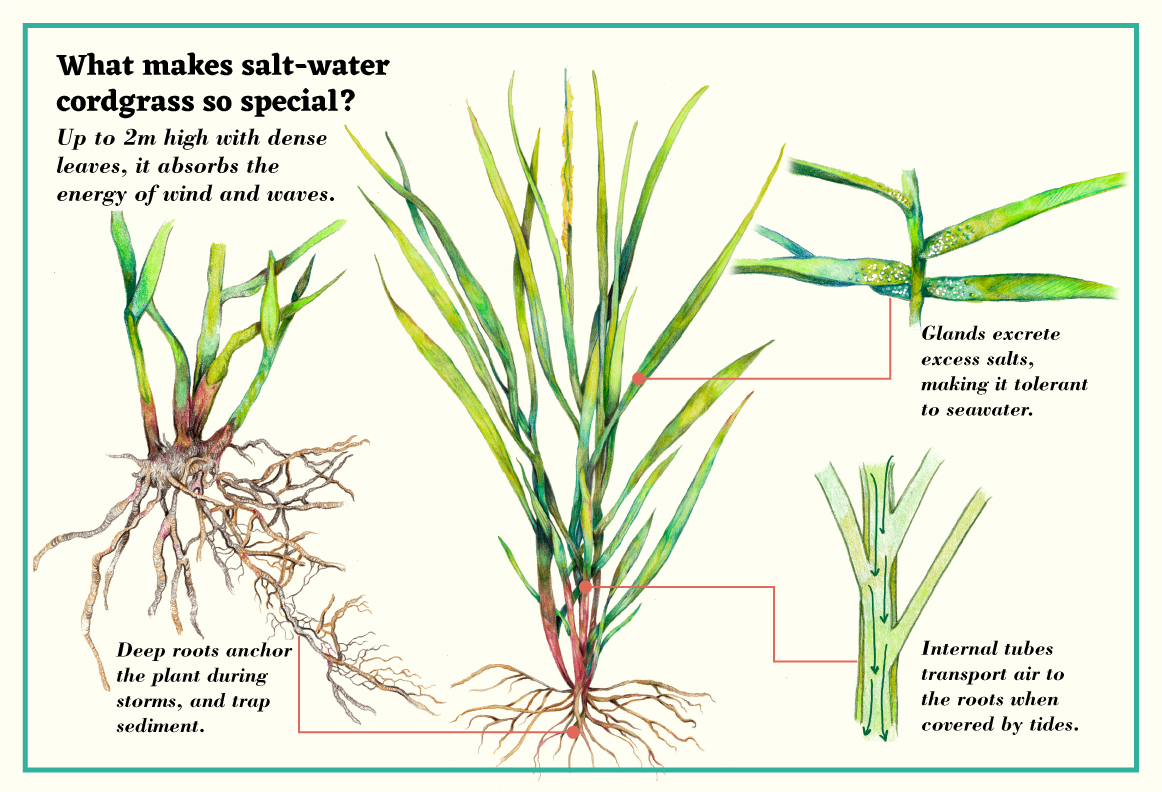
Beginning in 1978, China’s reform and opening-up led to a rush to reclaim land from the sea, and many coastal areas systematically planted salt-water cordgrass to help with that process. In the late 1990s, Shanghai planted it between Shazhou and Jiuduansha, at the mouth of the Yangtze, as part of construction of Pudong International Airport.
The damage the cordgrass was doing gradually became apparent. In Zhejiang and Fujian, it blocked shipping channels and caused algal blooms. In southern China, it invaded mangrove swamps. In Shanghai and Jiangsu, it outcompeted local species and took over bird habitats. Jiangsu fishers complained that once it took over a beach, the mud snails and mudskippers they used to catch could no longer be found. Research found its dense stalks and root systems wrecked populations of large benthic animals such as snails, shellfish and crabs.
In 2003, inspired by an International Union for Conservation of Nature’s list of invasive species, the State Environmental Protection Agency (now the Ministry of Ecology and Environment) published China’s first list of invasive species. Salt-water cordgrass was one of the 16 named. Despite that, China still hadn’t done much research into the harm the plant was doing. In fact, the concept of guarding against invasive species was only just taking root.
Two years before the list was published, Li Bo, a professor at Fudan University’s School of Life Sciences, had seen how invasive the plant could be. He assigned a PhD student, Chen Zhongyi, to study the cordgrass. In 2004, Chen completed his thesis on the consequences of the introduction of salt-water cordgrass in Dongtan. This was the first systematic study of the impact of the plant on other wetlands plants, benthic animals and birds.
Chen found the salt-water cordgrass was restricting, and even killing off, a local sedge species, Scirpus mariqueter, one of the most common plants in the salt marshes at the mouth of the Yangtze. Once the cordgrass had taken over, birds lost their habitats and food source.
Many migratory birds find food in the sand and mud of open beaches. They arrive from the far south in March and April to rest here, when Scirpus mariqueter is still low on the ground. But salt-water cordgrass survives the winter and can be half a metre tall and covering 60% of the beach by April. That makes finding food an arduous task for the birds.
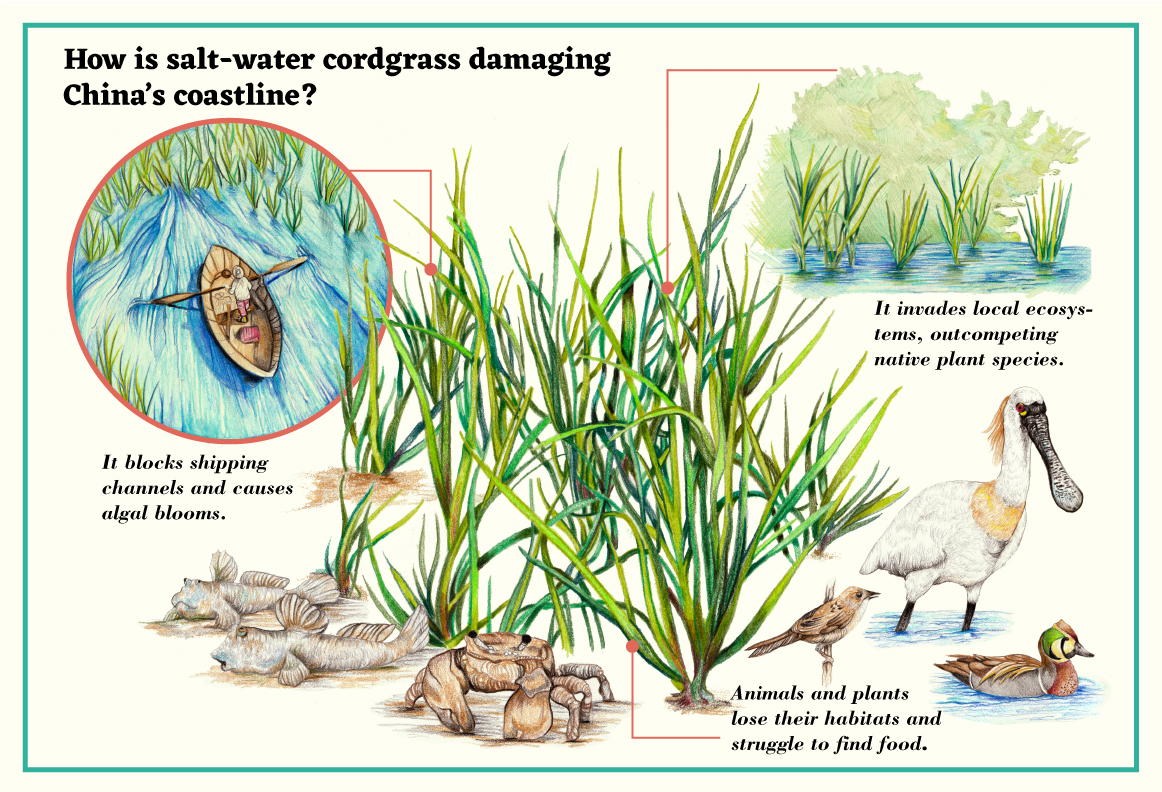
It’s the same story in many wetlands on the coasts of the Yellow and Bohai seas. These are important, perhaps irreplaceable, resting points for rare and endangered species such as the spoon-billed sandpiper, far eastern curlew and great knot as they make their epic journey along the East Asia–Australasia Flyway. This role led to the awarding of world heritage status to the migratory bird sanctuaries along the coast of the Yellow Sea–Bohai Gulf. The only other world heritage site of this type is in northern Europe, on the Wadden Sea. Unfortunately, the Yellow and Bohai coasts are also ideal habitats for the salt-water cordgrass.
Its 2003 designation as an invasive species did not halt the spread. According to Zhang Zhaohui, colonisation sped up from 2010 onwards, reaching a peak in 2015. The spread slowed after that only because it had “already taken over all possible habitats”. As conservationist Gan Xiaojing describes, these areas are now all covered with tall dense grass and the stench of rotting vegetation. They might be green, but for many birds and benthic species, they are deserts hostile to life.
Costly control
Salt-water cordgrass is particularly hard to control as it can propagate both from its seeds, which the sea spreads far and wide, and its rhizomes, which spread outwards before growing upwards into new plants.
In late 2012, the State Forestry Administration and Shanghai’s government launched a project to tackle cordgrass in Dongtan – the 1.16 billion yuan undertaking mentioned earlier. The approach was two-pronged: cut the plant down above ground to prevent seeds spreading; then submerge the rhizomes in water for at least six months to deprive them of oxygen. Engineers built a 27km dyke around the area to be treated, with sluice gates to keep the water level at a minimum of 40cm. Once the cordgrass had been killed off, local species friendly to birds, such as Scirpus mariqueter and reeds, were planted.
Once the project had been completed in 2018, an assessment produced by the Shanghai government found that 95% of the cordgrass had been eliminated and the dominance of the plant in Dongtan ended. Scirpus mariqueter was recovering in some areas, and bird populations had increased.
But most provincial government cannot afford to spend over a billion yuan to treat 24km2, at a cost of 48 million yuan per square kilometre. Industry insiders generally consider Dongtan a model project, but one too pricey to be widely replicated.
“Even Jiuduansha, across the river, is unlikely to benefit from the same approach. Locally appropriate measures need to be taken,” said Li Bo, who was involved in the project. As the Jiuduansha wetlands aren’t as well served by transportation as Dongtan, the same methods would be even more expensive there. But, he thinks some elements of the Dongtan project could be applied, such as cutting down the cordgrass and building a more temporary dyke, and planting local species.
Move 180km to the north, at Xiaoyangkou in the Jiangsu county of Rudong, and a slightly different approach has been tried since 2019.
Zhang Zhaohui, technical head for the project, took advantage of shipping channel dredging happening locally. First, the cordgrass was cut and removed. Then dredged silt was used to cover up any shoots. The level of silt had to be carefully controlled, high enough to prevent the plant getting any light, but not so high as to remain dry at high tide. “Otherwise it would just have been another land reclamation project,” said Zhang.
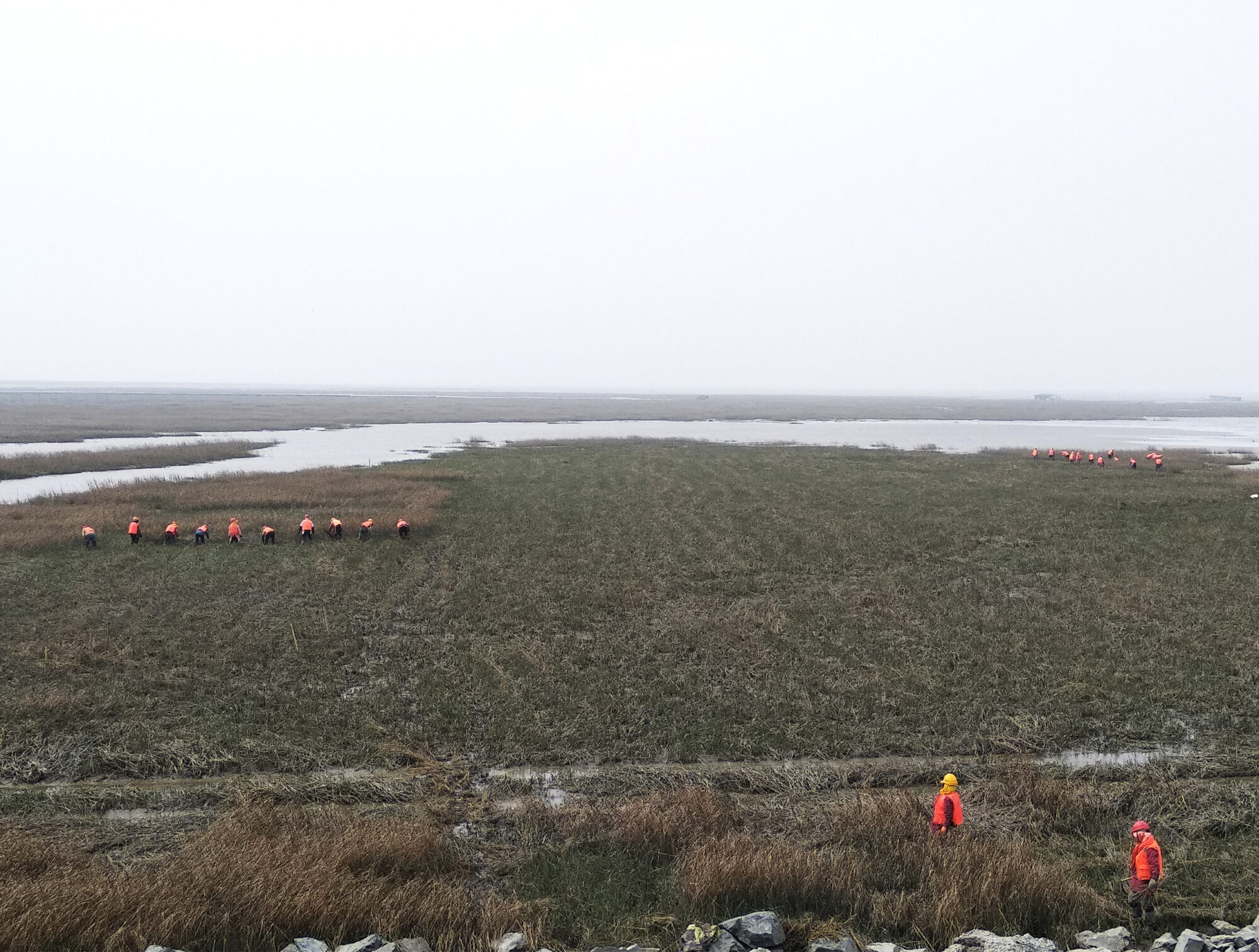
According to follow-up monitoring, 98% of salt-water cordgrass had been removed by the time the project ended in 2020, with three to five times as many species of birds being seen compared with untreated areas, and in far greater numbers. Those included nine spoon-billed sandpipers, a Class I protected species.
The treated area comprised 4.88km2 at a cost of 170 million yuan, or 35 million yuan per square kilometre.
Prevention issues
Large-scale remediation of cordgrass infestations is possible, then, but the biggest problem is a lack of techniques for follow-up management, says Zhang Zhaohui. “You can clear out huge expanses of the plant, but seeds blow in, or float in, and take root again,” he said. “All you can do is have someone walk about, uprooting any seedlings they spot. That’s the only option. But if you don’t do it, all earlier efforts are wasted. It’ll grow back within three years.”

According to Zhang, current thinking is to strengthen that ongoing management, along with an approach tailored to local circumstances. This will see strategies chosen based on the nature of the coastline, the intensity of the cordgrass infestation and the urgency of remedial measures. For example, bird habitats and reserves will be regarded as more urgent, requiring less intrusive approaches. In some places, cordgrass serves a useful function as it helps protect oil and wind power infrastructure. There, it will be allowed to remain, but not spread, and treated less urgently. Zhang thinks two things need to be done to prevent that retained cordgrass from spreading: regular cutting to prevent seeds maturing and digging trenches to prevent rhizomes spreading.
But experts told China Dialogue that salt-water cordgrass should be eliminated nationwide, as far as possible. Measures such as regular cutting will require ongoing funding and labour, and it is never going to be possible to clear the seeds quickly enough, they said.
Herbicides offer a cheaper and fast-acting alternative, but toxicity is an obvious concern. Currently, China only uses herbicides on small-scale projects due to the unknown environmental risks associated with wider use. Experts point out that herbicides have never been used as the main treatment method in a large government-funded project. In existing projects, herbicides are only used where engineering approaches cannot reach, such as patches of beach outside dykes.
Another approach is being used in the mangrove swamps of southern China – replacement with other species. Pan Lianghao, an assistant researcher at the Guangxi Mangrove Research Centre, told China Dialogue that salt-water cordgrass is still spreading along Guangxi’s coast and preventing the growth of mangrove swamps. While the big engineering approaches taken further north may be suitable on large and silty river mouths, they can’t be applied in swamps. Currently, manually or semi-mechanised approaches are used to remove the cordgrass, then suitable mangrove vegetation is planted, to prevent it taking root again.
This is a cheaper approach, but can be misapplied. Replacement species need to grow faster than the cordgrass, so early on some projects just opted for the fastest-growing options. In the city of Zhuhai, for example, Sonneratia apetala and Laguncularia racemosa were planted in the Qi’ao Island mangrove swamps. The problem is, neither are local species.

Sonneratia apetala was the first imported mangrove species to be planted on a wide scale, and has become the most used tree in mangrove swamp restorations on China’s southern coast. But there has been disagreement over whether or not it will have a negative impact on the growth of local mangrove species, or itself become an invasive species. It can take decades for the invasive nature of an imported species to become apparent, leading some academics to call for a highly cautious approach to be taken with Sonneratia apetala, to avoid another plant imported as a solution becoming a problem in its own right.
“There’s still scientific debate over whether or not Sonneratia apetala could become invasive,” said Pan. But, without enough data to know either way, there is a chance it could be, and he does not suggest using it to tackle salt-water cordgrass. Fudan University’s Li Bo thinks careful risk assessments are needed for the introduction of any species. “Otherwise, a heavy price may have to be paid.”
Currently, Zhuhai is working to replant the Qi’ao Island mangrove swamps with local species, rather than Sonneratia apetala and Laguncularia racemosa. “In the end, you need to use local species as the solution,” said Pan.
